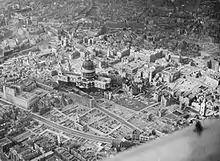Bombsite
A bombsite is the wreckage that remains after a bomb has destroyed a building or other structure.

World War II bombsites
After World War II many European cities remained severely damaged from bombing. London and other British cities which had suffered the Blitz were pock-marked with bombsites, vacant lots covered in the rubble of destroyed buildings. Many postwar children in urban areas shared a common memory of playing their games and riding their bicycles across these desolate environments.[1][2] There were often abandoned bombshelters of the 'Anderson' type nearby.
In London, Liverpool, Bristol, etc., across the channel in Berlin and other places these sites were constant reminders of the death and destruction of the war. This was a contributory factor to the European psycho-sociological outlook of the 1950s and 1960s.[3][4][5] The German city of Dresden suffered a previously unprecedented level of destruction.[6]
In literature and media
The rubble of Viennese bombsites and the remnants of the city's battered infrastructure serve as a backdrop to much of the action in the movie The Third Man, written by Graham Greene, an author who would return to this bombsite motif again in his 1954 short story "The Destructors".
References
- Clark, Fred (8 May 2005). "Bombed Houses and Bomb Sites". WW2 People's War: An archive of World War Two memories - written by the public, gathered by the BBC. BBC. Retrieved 8 September 2010.
- Hill, Roy J. (19 February 2009). "Britain at War: Bomb sites were interesting". The Daily Telegraph. Retrieved 8 September 2010.
- Schofield, John; Johnson, William Gray; Beck, Colleen M. (2004). Materiel Culture: The Archaeology of Twentieth-Century Conflict. One World Archaeology. 44. Taylor and Francis. ISBN 978-0-203-16574-4.
- Stephan, Hans (January 1959). "Rebuilding Berlin". The Town Planning Review. Liverpool University Press. 29 (4): 207–226. doi:10.3828/tpr.29.4.v855122271m87750. JSTOR 40102263.
-
New Society. New Society Ltd. 59: 217–218. 1982. Missing or empty
|title=(help) - "Photo Gallery: Dresden's Postwar Ambitions Divide Architects". Der Spiegel.
External links
- Photograph: Bristol's last Bomb Site
- London Discovery Tours offers walks around the London bomb sites
- Photograph: Open spaces in Portsmouth where bombs had fallen
- Photographs: World War 2 Bomb Sites
- On Google Maps: V2 sites in Walthamstow
- Summary of 'The Destructors' by Graham Greene (from litsum.com)
- Summary of 'The Destructors' by Graham Greene (from enotes.com)
- Other essays analysing Graham Greene's 'The Destructors'
- Images of London bomb damage and related material
- The Psychological effects of war and violence on children By Lewis A. Leavitt, Nathan A. Fox on Google Books
Further reading
- Moshenska, G. (2009). "Resonant Materiality and Violent Remembering: Archaeology, Memory and Bombing". International Journal of Heritage Studies. 15 (1): 44–56. doi:10.1080/13527250902746062.
- Mellor, L. (2004). "Words from the bombsites: debris, modernism and literary salvage". Critical Quarterly. 46 (4): 77–90. doi:10.1111/j.0011-1562.2004.00598.x.
- Schofield, John (2002). "Monuments and the memories of war: motivations for preserving military sites in England". In Beck, Colleen M.; Johnson, William Gray; Schofield, John (eds.). Matériel Culture: The Archaeology of Twentieth-Century Conflict. One World Archaeology. 44. London, UK: Routledge. pp. 143–158.
- James, J. (2006). "Undoing Trauma: Reconstructing the Church of Our Lady in Dresden". Ethos. 34 (2): 244–272. doi:10.1525/eth.2006.34.2.244. S2CID 84177597.
- Moeller, Robert G. (2006). "On the History of Man-made Destruction: Loss, Death, Memory, and Germany in the Bombing War". History Workshop Journal. 61: 103–134. doi:10.1093/hwj/dbi057.